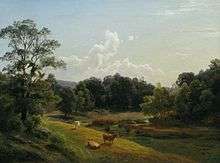Paul Weber (artist)
| Paul Weber | |
|---|---|
.jpg) | |
| Born |
19 January 1823 Darmstadt |
| Died |
12 October 1916 (aged 93) Munich |
| Nationality | German |
Gottlieb Daniel Paul Weber (Darmstadt, 19 January 1823 – Munich 12 October 1916) was a German artist.
Life
He was born in Darmstadt as a son of the composer Johann Daniel Weber (1784–1848). He studied art in Frankfurt at the Städelschule from 1844 to 1848. He completed his studies with Josephus Laurentius Dyckmans in Antwerp.[1] To study at the Munich Academy he moved together with Anton Burger to Munich, during the studies he accompanied Prince Regent Luitpold of Bavaria on a trip to the Eastern Mediterranean, which led him to Constantinople, Asia Minor, Greece and Sicily. He completed his artistic training at Josephus Laurentius Dyckmans in Antwerp.
In 1848 soon after the collapse of the German Republic, at the age of 25, he moved to the United States, settling in Philadelphia, where he was a frequent exhibitor at the Pennsylvania Academy of the Fine Arts from 1849 onward. He also exhibited at the National Academy of Design, the Brooklyn Art Association, the Boston Athaeneum, the Washington Art Association, and the Paris Salon. Among his students in the class of landscape painting were William Trost Richards, William Stanley Haseltine and Edward Moran. He influenced the Hudson River School.[2] In 1850 his son Carl Weber was born, who became later also a painter of the Hudson River School.
In 1858 he returned to Darmstadt via Scotland (1861) and France (1864). In France he spent some time at the Barbizon school. At the court he worked mainly as a lecturer of Princess Alice of the United Kingdom, privately he also taught Phillip Röth, who had married his daughter Pauline. Together with Eugen Bracht they made some journeys for painting in the landscape. Paul Weber travelled also some times back to the United States, where his works were shown on the National Academy of Design and the Boston Athenaeum.
In 1872 Paul Weber moved to Munich, the German art metropolis at that time. He painted urban genre scenes and the still existing rural landscape around Munich.
Works

- “A Scene in the Catskills,” in the Corcoran Gallery, Washington (1858)
- “Morning,” in the Pennsylvania Academy of Fine Arts
- “Wooded landscape with Lake and Mountains”, Metropolitan Museum of Art New York
- “Forest scene”, The Walters Art Museum Baltimore
- “Children in Oberhessen”, Hessisches Landesmuseum (1868)
- “Peat bogs”, Neue Pinakothek Munich (1885), lost
- “Study”, Neue Pinakothek Munich
- “Sunny autumn day in Odenwald”, Stadtarchiv Darmstadt
- “Riverscape”, formerly collection Otto Rothschild (now lost)
- “Landscape overlooking the Hudson River” (1855), privately owned (shown in the Museum Giersch)
- “Count Arco Chapel at Berchtesgaden”, formerly collection Abraham Adelsberger (lost)
- “Landscape” in the Arnot Art Museum
Awards
- 1858: Silver medal of the Academy of Fine Arts Philadelphia
- 1865: Golden medal at the exhibition at the London Crystal Palace
Exhibitions (selection)
- 1901: VIII. International art exhibition in the glass palace, Munich
- 1902 Great Berlin Art Exhibition
- 1912: Munich annual exhibition in the glass palace
- 1917: Paul Weber Memorial at the Heinemann Gallery, Munich
- 1918: Paul Weber Darmstädter Kunstverein
Notes
References
| Wikimedia Commons has media related to Paul Weber. |
